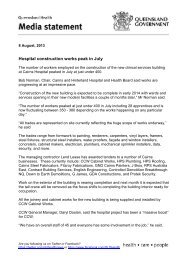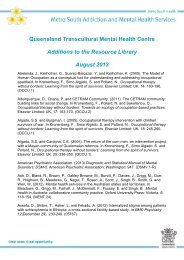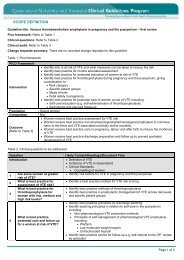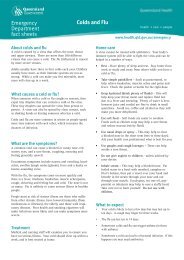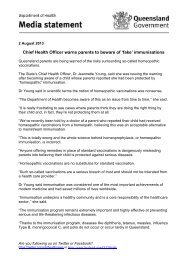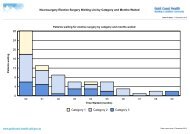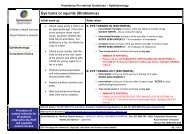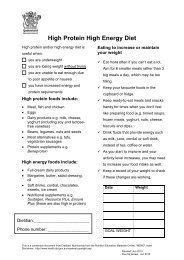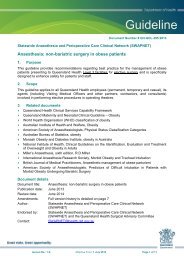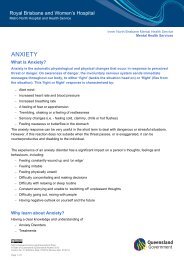Paediatrics - Queensland Health - Queensland Government
Paediatrics - Queensland Health - Queensland Government
Paediatrics - Queensland Health - Queensland Government
You also want an ePaper? Increase the reach of your titles
YUMPU automatically turns print PDFs into web optimized ePapers that Google loves.
Gastrointestinal problems<br />
616<br />
Controlled copy V1.0<br />
Constipation<br />
Recommend<br />
Maintenance programs consisting of medication, toileting program, dietary advice<br />
and follow up to prevent recurrence<br />
Background<br />
Constipation is the difficult passage of infrequent dry, hard stools that often cause<br />
pain and discomfort. The most common cause is functional - no underlying cause [8]<br />
Constipation starts a vicious cycle - passing hard stool is painful, so the child avoids<br />
straining at stool, the constipation gets worse and so on. Part of the battle is forming<br />
a habit for the child to go to the toilet each day<br />
Straining is normal in babies<br />
1. May present with<br />
• Hard stool - often small pellets<br />
• Excessive straining at stool<br />
• Soiling (also known as encopresis)<br />
2. Immediate management Not applicable<br />
3. Clinical assessment<br />
• Obtain a complete patient history including:<br />
- - medical history<br />
- - past episodes<br />
- - current diet including food allergies [6]<br />
- - fluid intake - are they breastfeeding or on formula? how is the formula made<br />
up? (Over concentrated formula can lead to constipation.) Are they given<br />
water as well?<br />
- - what / how much is their physical activity?<br />
- - family routine (the constipated child usually has poor nutrition, poor fluid<br />
intake and is inactive)<br />
- - parental expectations of ‘normal’ stool pattern<br />
- - length of time since last passed a stool / defecated?<br />
- - describe stool, colour, consistency, frequency of defecation<br />
- - ask carer if any change in child’s behaviour?<br />
- - what is there urinary output history? are they bedwetting? daytime wetting?<br />
- - is the child on medication?<br />
• Perform standard clinical observations +<br />
- - weigh - use naked weight in young children and record against most recent<br />
- - plot growth and height / length<br />
• Perform physical examination:<br />
- - inspect mouth, look for mouth ulcer(s) and state of teeth / gums<br />
- - inspect and palpate abdomen - for masses<br />
- - ankle knee reflexes (to assess sacral nerve roots and gait)<br />
- - inspect the anus and perianal area - position of the anus, pressure of stool<br />
around anus, perineal sensation, skin tags, anal fissures<br />
• Consider possible organic problem (and refer for further work up) if:<br />
-- child has constipation from birth<br />
-- child has vomiting, and abdominal distension<br />
-- there is any bile vomiting<br />
-- the child is not growing well<br />
-- there is more than just a streak of blood on the stool<br />
-- constipation does not improve with simple measures<br />
Primary Clinical Care Manual 2011



